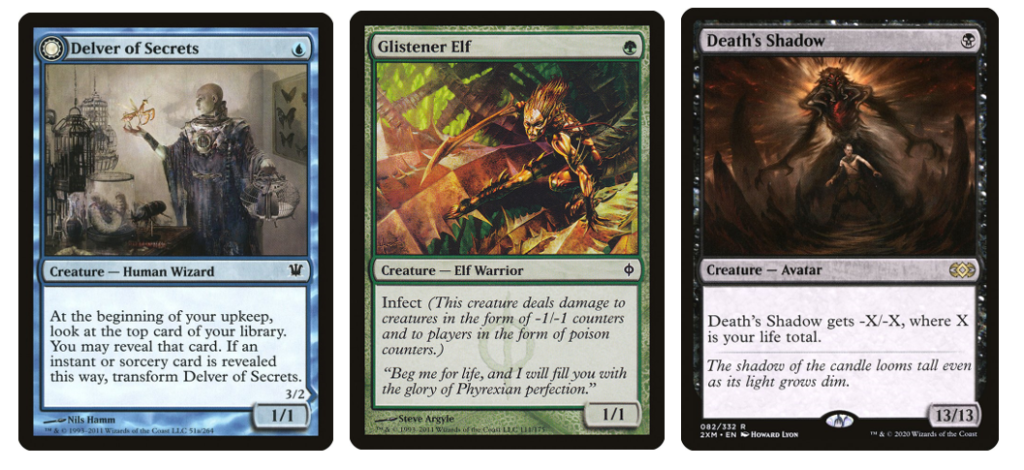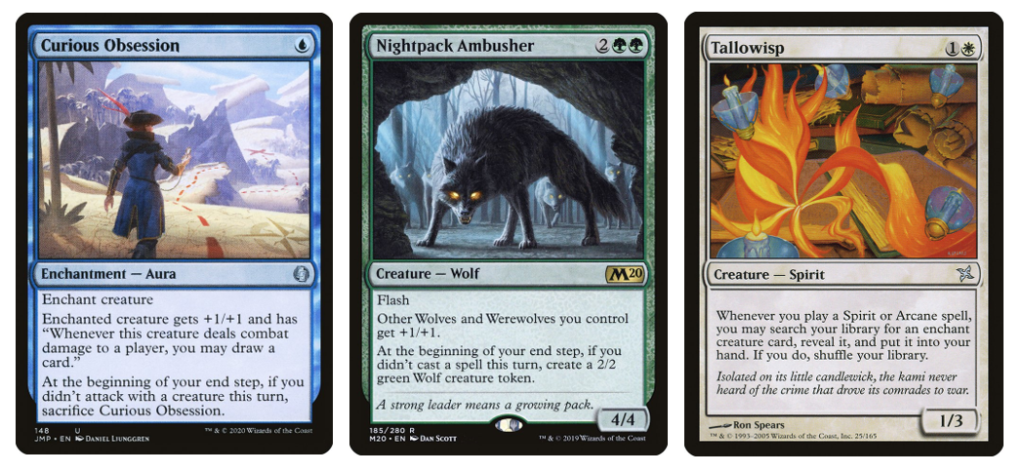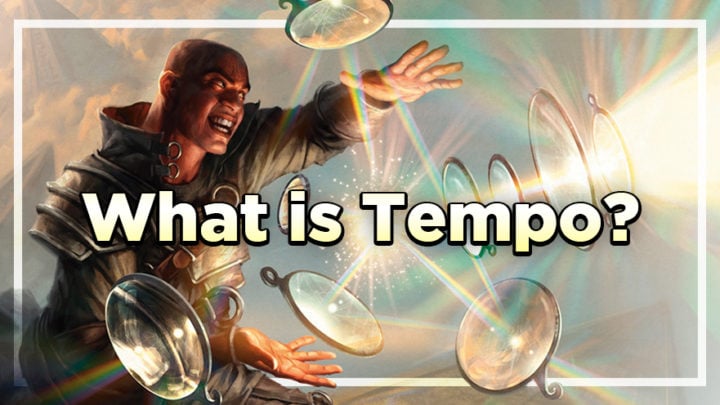This week, I’m rolling up my sleeves to tackle one of life’s great questions: what does “tempo” mean in Magic: The Gathering?
It’s a controversial bit of jargon among Magic players even at the highest level, and this is far from the first article written about it. I have faint memories of reading one by Ben Bleiweiss back in Guildpact Standard when I was getting to grips with the game; even that opened by admitting “in Magic, the exact definition of tempo has been murky at best.” Nearly 15 years later, we still haven’t done much to clear the waters: most players will either laugh “tempo” off as a meaningless buzzword, or simply claim they know it when they see it.
But I suspect that tempo is not really that mystifying a concept. There is indeed a common thread between every article discussing the concept, every archetype labeled a “tempo deck” in its time. Once you understand the rules, it’s easy to apply to your games — but almost all of us already do, whether you think of it as an underlying constant or just “good habits” with your favored deck.
Ready to hear it?
MANA: THE OTHER UNIVERSAL RESOURCE
Every deck in every format runs on the twin resources of cards and mana. And every game of Magic revolves around spending those resources as efficiently as possible to advance your gameplan. Card advantage (or “value”) is something most players understand well, and we all know that playing to maximize it is a sure path to victory. But what about the other resource? What does “mana advantage” look like, in a real game situation?
Players gain card advantage simply by spending cards more efficiently than their opponents. You may each start with one card a turn, but you break that parity by killing two of theirs with one of yours, or playing one card which draws two cards. Of course, it’s possible to do the same with mana, since each player has a fixed income of it to trade with each untap step. If you’ve ever cast Edgewall Innkeeper with your turn one mana while your opponent just played a land and passed, you know you’ve gained some kind of advantage in the game!

That’s tempo. It’s the advantage gained by spending mana more effectively than your opponent, and often — though not always — used as a counterpoint to balance card advantage. It’s very hard to get ahead on both resources at the same time, so at any given point in a match, it’s important to understand where you are gaining advantage, and where it’s costing you.
“Who’s the Beatdown?” is widely recognized as one of the most brilliant and useful bits of theory for understanding Magic. But the idea of “being the beatdown” is a little abstract, and ignores non-damage methods of applying pressure. What I think this venerable thought experiment really asks us is, “Which player should be playing to create a tempo advantage, and which should be playing for card advantage?”
“TEMPO” THE CONCEPT VS. “TEMPO” THE DECK
Because every deck has at least some relationship to tempo, the term “tempo deck” can seem confusing. A “tempo deck” is simply a deck where the card choices are unusually focused on building a tempo or mana advantage. This can be achieved by playing multiple efficient, impactful cards each turn, outpacing your opponent by volume. You can force their mana to go to waste each turn, denying them meaningful ways to spend it or simply countering everything they do — hopefully while your cheap impactful threats get the job done on an empty board. As we all know from our worst draws, it only takes a few turns of not impacting the board with your mana for the game to slip away…

Since all of this is incredibly inefficient on cards, the key enabler for a viable tempo strategy is some extremely cheap (or instant-speed) card advantage engine. Curious Obsession fueled Autumn Burchett’s Mono-Blue deck at the first Mythic Championship, Nightpack Ambusher was essentially worth a card per turn for Simic Flash decks, and the Ghost Dad deck Ben Bleiweiss proclaimed “one of the finest examples of a tempo deck in Magic history” ran rampant thanks to Dark Confidant and Tallowisp.

But as I alluded, even the most familiar and foundational deck archetypes are defined by how they play to gain (or negate) windows of tempo or mana advantage. And approaching them on those terms is the clearest way to gain a high-level understanding of their match-ups.
HOW TEMPO WINS GAMES
Let’s look at a few examples of how different decks use tempo to their advantage.
Aggro
Typical fast aggro decks attempt to make better use of their first few turns of mana through cheap spells, burning through cards quickly in the hope they can win before that deficit starts to hurt them. They achieve greater mana efficiency by spending it only on effects that lead directly to killing the opponent ASAP. Utility effects which do not deal damage or engine cards with unreliable return are minimized in most cases to ensure a consistent clock regardless of the draw or enemy interaction.

Some aggro decks attempt to leverage broad synergies to deal more mana-efficient damage, like tribal decks or others that go wide to abuse team-wide pump effects. The faster and less fair the format, the more these sorts of decks take prominence over decks like Burn, which lean on individual card efficiency. But playing to maximize their early tempo lead is the defining characteristic. Where a slower deck might hesitate to Heartless Act an enemy chump blocker, for aggro, it is often correct to forgo that future value if it means you can push opposing development back one more turn.
Most of the skill in playing classic, burn-heavy red aggro decks lies in correctly utilizing tempo. Consider a typical Mono-Red vs. UW Control match-up from any Standard format. The Mono-Red curve is extremely aggressive — they could be casting multiple spells as early as turn two. With a low land count and cheap, proactive spells, they will always be using their first few turns of mana efficiently.
By contrast, the UW Control deck is unlikely to have any proactive plays that affect the board until turn three, four, even five! The mana available on these turns is essentially wasted, while the red deck massively overperforms. The typical early mana investments for Standard control decks focus on setting up their later turns — laying multicolored taplands to fix their mana; cantripping or foretelling cards to sculpt their next turn’s options. Even if they try to line up one-for-one reactive plays like counterspells or removal, the red deck’s spells are cheaper and designed to front-load their value; killing a haste creature after it has attacked is still a poor return on your mana.
Once the opponent is low enough on life, the threat of burst damage in the form of burn spells or haste creatures becomes another way to exact a tempo advantage. When the red player is holding cards and mana which might represent lethal, the blue-white player feels pressured to hold up at least enough mana for a life-saving counter or lifegain spell. So long as the red player maintains this state, that is three or more mana per turn wasted — a significant tempo swing which allows smart red pilots to stay in the game even when things seem tight.
Control
Typical control decks tend to sacrifice tempo (and life) in the early game, but snatch it back later on. Drawing more cards ensures you draw more lands and more spells to play with them — by definition, using mana more effectively than your opponent on each turn.
When they can maintain parity on board, the threat of countermagic can sometimes force opponents to avoid casting expensive spells, wasting their mana for the turn. If the control deck is able to then play a proactive cantrip, removal spell or flash creature in that end step, they can net their own huge tempo advantage and begin taking over.
Most late-game threats out of control decks cut off the ways your opponent can spend their mana meaningfully on future turns. Burn spells and even small ground creatures aren’t much good against Dream Trawler, for instance.

Depending on how much pressure they’re feeling from aggro decks, control builds are forced to play cheaper one-for-one interaction, giving up a little of their card advantage focus to keep up on early tempo. The extreme situation is cards like Unsummon or Unsubstantiate, which are extremely cheap, but only trade for mana rather than an opposing card. These cards solely provide tempo advantage — they are hugely inefficient over the long term — and thus bounce spells, fogs, or tap-down effects are sometimes specifically called out as “tempo cards.”
Combo/Midrange
Combo decks have less in common in terms of deck construction, but it is worth calling out the particular tempo advantage gained by having such an explosive win condition.

Many combo decks can win in a single turn with little or no warning. They generate pressure in a similar way to an aggro deck, but without needing to keep the opponent’s life low. And because the combo deck ends the game on the spot instead of stabilizing gradually, it can even pressure opponents into spending mana inefficiently to maximize early pressure.
Combo decks are some of the most likely to play tempo-focused disruption like Unsummon or Fog, because they can afford to ignore the long-term card disadvantage (like aggro), but do not need every card to contribute directly to their win-con.
On the other hand, midrange decks are the least likely to devote card slots purely to creating tempo advantage. Their entire philosophy is to use cards that consistently trade well on net resources, and tempo cards are at the bottom of that scale by definition.

However, by insisting on playing only cards which are mana-efficient for their cost and generate maximum value, these decks can passively build up a tempo advantage over time.
Every time your Elder Gargaroth stonewalls an aggro deck for a turn, or your Kaya exiles a permanent while sticking around to do more next turn, you’re generating a bit more of an edge on mana, even if you don’t always go up cards.
MAYBE THE TEMPO WAS INSIDE US ALL ALONG?
So, if tempo is so fundamental to Magic, why is it still so hard for players to understand?
Card advantage is an easy concept to grasp and track once you’ve had enough experience in Magic. We’re sharply aware of the cards in our hand and on the field, and we feel very keenly when we lose a bunch of them at once to a sweeper. By contrast, you get a fresh batch of mana every turn, so it is very rarely the obvious bottleneck to in-game success. And when it is, we tend to blame it on not drawing enough cards to see lands.
But as games get closer and more competitive, mana advantage — tempo — becomes a deciding factor more and more often. Hopefully, this article has driven home just how tightly tempo is woven into every game of Magic — one that you can plan around, or even turn to your advantage.

Tom’s fate was sealed in 7th grade when his friend lent him a pile of commons to play Magic. He quickly picked up Boros and Orzhov decks in Ravnica block and has remained a staunch white magician ever since. A fan of all Constructed formats, he enjoys studying the history of the tournament meta. He specializes in midrange decks, especially Death & Taxes and Martyr Proc. One day, he swears he will win an MCQ with Evershrike. Ask him how at @AWanderingBard, or watch him stream Magic at twitch.tv/TheWanderingBard.

